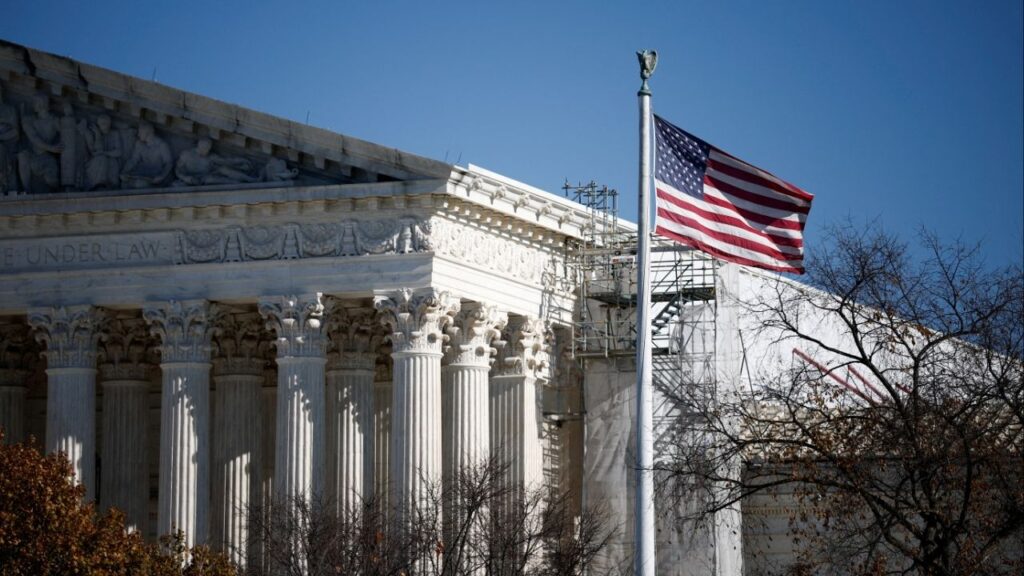Share
BY BYRHONDA LYONS
CalMatters
Outside the Colusa County Courthouse Annex, 21-year-old Lorenzo Acosta takes a few puffs from his vape cartridge to calm himself before walking into court to support a friend.
Acosta acknowledges he’s been “in the system,” so he knows how it all works here. He knows the police, the public defenders, the judge who, he says, hands out extended lectures. But Acosta has never before realized one of the most glaring facts about the local bench of judges who help determine people’s punishments:
In Colusa County, where 60% of the population is Latino, both of the Superior Court judges — who handle everything from disorderly conduct to murder trials — are white.
His eyes widen. “That’s crazy, for real? Deadass?” he asks. Then he slowly shakes his head. “Actually, thinking about it now, I’ve only seen white judges.”
Colusa is one of four majority-Latino California counties — along with Kings, Madera, and Merced — with no Latino judges in any superior courtrooms. Latino representation on the bench in three of those counties has not improved much since the state began collecting judicial diversity data 14 years ago. And the fourth, Kings — which had one Latino judge in 2007 — is back down to zero.
“I wouldn’t have expected it to be that bad,” said Lisa Pruitt, a law professor at the University of California, Davis who helped with the state’s research on attorney access in rural California.
Other Counties Lack Represententative Numbers of Latino Judges
In 13 other California counties, there’s a gap of 30 percentage points or more between the percentage of Latinos in the population and the percentage of Latino judges. The gaps tend to be greatest in the Central Valley, but also include counties such as Los Angeles, Monterey, and San Bernardino.
For years, the focus on fairness and equity within the criminal justice system has been on policing, with far less scrutiny to the component of the justice system that wields vast power over attorneys, defendants and how cases are viewed by juries.
Judges “often set rules for how the courts across the state or across the county will decide certain cases or how they’ll treat parties before them,” said Douglas Keith, an attorney for the Brennan Center for Justice, a progressive think tank on law and policy. “Who sits on these benches can have a significant impact.”
In California, bench representation is worse for Latinos than any other racial group.
And such disparities can have effects that ripple through individual lives and entire communities. Research indicates that racially diverse judges and women judges tend to assess certain cases differently, on average, from their white and male counterparts.
And while roughly 60% of white and Asian-Americans felt California county courts were fair over half the time, only about 40% of Latinos felt the same, according to a study commissioned by the California Judicial Council.
How has this situation persisted in some California counties? One clear factor is a lack of practicing Latino attorneys in the area — the pool from which judicial appointments are drawn. Others cite the appointments process itself — blaming a good ‘ole boy appointments system that, until recently, was shrouded in secrecy.
Regardless, years of planning and programs aimed at diversifying the bench have yielded exceptional results in some counties, decent results in others, and whites-only benches in a few.

Alarm Sounded on Absence of Judicial Diversity
There are roughly 1,600 superior court judges throughout California. The State Bar, the Hispanic Bar Association and the California Association of Black Lawyers have sounded the alarm about a lack of diversity on the bench for years.
Since the state began releasing judicial diversity data in 2007, the number of Latino trial court judges, statewide, has nearly doubled, going from 96 to 184. Although the percentage of white judges has dropped a bit, they still make up more than 60% of all trial court judges in California, as they did 14 years ago.
While adding people from different backgrounds and life experiences can lead to litigants feeling more trustful of the judicial system, it’s not the only reason diversity is important.
It’s been more than a decade since then-President Barack Obama named to the U.S. Supreme Court a New Yorker, Sonia Sotomayor, who had famously — and controversially — said at a UC Berkeley symposium: “I would hope that a wise Latina woman with the richness of her experiences would more often than not reach a better conclusion than a white male who hasn’t lived that life.”
Several studies have attempted to tease out the link between a judge’s race or ethnicity and that judge’s rulings and sentencing behavior. The reported results have been mixed — perhaps reflecting the interplay of a variety of factors that correlate to race and ethnicity, including political ideology.
Yale University professor Allison Harris’ research into Chicago’s Cook County found that having Black judges around made white judges more fair and led to sentencing equity for Black and white defendants. Among her conclusions: “increasing the number of judges who look like the majority of defendants could reduce those defendants’ likelihood of being imprisoned.”
A study published by the American Bar Foundation found that having a diverse bench can also affect judicial outcomes: Researchers discovered that white judges dismissed 61% of federal cases in which employees alleged workplace discrimination, while judges of color dismissed a dramatically lower 38%. White judges also were particularly more likely to dismiss cases involving minority plaintiffs than those involving white plaintiffs.
“We want to think of the law as kind of interchangeable and they just apply the law to the facts, but that’s not what all judges are doing,” said Northwestern University Law professor Laura Beth Nielsen, who conducted the research.
In another Cornell Law School study of implicit bias among trial court judges, researchers presented several hypothetical cases and found that judges, like most people, have implicit biases that can affect their judgement. The study also found that judges can suppress those unconscious biases.
What may be research fodder for academics is palpable for attorneys, plaintiffs and defendants when they walk into a courtroom.
“It is…intimidating. It is infuriating. It is not shocking,” said Felicia Espinosa, describing what it feels like to be the only Latina attorney in court. She works in Fresno, where she’s one of roughly 2,200 attorneys in the county for a population of nearly 1 million, according to data from the California State Bar.
“I’m both dealing with my own internal feelings and thinking about my client and how it impacts them,” said Espinosa, advocacy director for Root & Rebound, which offers legal aid for people who were once in jail or prison.
Colusa Courthouse Reflects the Deep South
Along the hour drive from Sacramento to Colusa, rows of nut trees and farmland line Lone Star Road leading into town. Dotted with rice fields, almond trees and small farmworker communities, this small county grows about $1 billion worth of food a year.
The town’s square has the feel of an old Western town with a touch of the plantation. That’s not an exaggeration: The towering courthouse, built in 1861, reflects the county’s heritage from the “ANTE-BELLUM SOUTH AND STATES RIGHTS SYMPATHIES DURING THE CIVIL WAR,” according to a plaque added to the building in 1976. It stood in for a Deep South courthouse in the 1962 classic film “To Kill a Mockingbird.”

Every week hundreds of people file into the courthouse for traffic court, land titles and the like. A couple of blocks away, outfitted with metal detectors and x-ray machines, the Annex is where many criminal cases are heard.
From morning to afternoon in these COVID-affected days, dozens of mask-wearing litigants and their supporters wait in small wooden chairs, distanced by more chairs and plastic partitions, for their chance to address the court.
Case by case, individuals rise to speak. Often their eyes dart around, looking for the court interpreter who dashes over to translate the legal jargon into Spanish.
“¿Podría repetir la pregunta? No entiendo lo que quieres decir,” one defendant implores the judge through interpreter Juanita Ulloa — asking if a question could be repeated because he didn’t understand it.
Just beyond Ulloa, photos hang along the wall, marking a time in history when the bench was filled with white men. Things have changed a little since then. Colusa County welcomed its first woman judge in 2010, an appointment by then-Gov. Arnold Schwarzenegger. But the bench has not caught up to the county’s demographics.
“I’ve always noticed that there were always white judges, white lawyers,” said Jessica Lopez, 32, of Williams, at the Colusa Annex to fight what she termed “a few” pending cases.
Only 7% of California Attorneys Are Latino
Of course it’s impossible to diversify the bench unless there are qualified Latino attorneys in these areas willing to trade in their briefcases for gavels.
In a state where Latinos make up 40% of the population — outnumbering all other groups — only 7% of California’s practicing attorneys are Latino.
Beyond its metropolitan areas, large swaths of California have too few attorneys to represent their population size. This has fueled attorney deserts where clients and attorneys have to travel miles and miles for meetings and court proceedings.
The State Bar data doesn’t break down the number of practicing attorneys in an area by race or ethnicity, making it impossible to pinpoint gaps where lawyers of color — and thus potential judges — are in short supply. Several Latino attorneys would not speak to CalMatters on-the-record because they’re only “a few of us,” said one Latino attorney who often appears in several different counties.
“That’s obviously a problem,” said Pruitt, the UC Davis law professor. “It is probably related to the fact that there’s a deficit of attorneys and probably a deficit of Latinx attorneys in those areas. A lot of law students are just not interested in going and working in rural California.”
No Longer Wants to be a Judge
It’s around noon when criminal defense attorney Roberto Marquez parks and heads inside a Colusa courtroom, positioning himself in the back and pacing back and forth between his client and the prosecutor.
As soon as he finishes addressing the court on behalf of his client, Marquez grabs his things and heads out the door — on to his next stop.
“Today, I’m in Colusa County, this morning I was in Yuba, and tomorrow, I’ll be who knows where,” Marquez explains later, his cell phone connection sputtering as he travels the rural roads to his next meeting. For more than 30 years, he has traveled as north as Butte County and as south as Sacramento County defending clients. He says he used to think about becoming a judge, but that now is a distant memory and he no longer feels a desire for judicial robes, having grown to love traveling a wide territory as a criminal defense attorney.
He’s also not convinced more Latino judges would affect his cases.
“I don’t need (judges) to be Hispanic, white, Brown, Black, or whatever,” said Marquez. “I just need them to be smart and follow the law, and I feel like I practice in front of some smart, fair-minded judges.”
Governor Appoints Most Judges
Most Superior Court judges first get the job because the governor appoints them after a sitting judge retires. The requirements: have at least 10 years’ experience practicing law, and submit a formal application.
Last year, 14% of state judicial candiates applicants were Latino. Deciding to leave practicing for judging is a difficult decision that can take a decade’s worth of planning, and some worry about a lack of Latino attorneys to back-fill them if they become judges.
For decades, judicial applicants had to know someone who knew someone to pitch themselves to regional Judicial Selection Advisory Committees, all composed of local attorneys and judges. These committees, the conduit to the governor’s office, have the power to make or break a judicial appointment.
The committee members were secret under former governors Arnold Schwarzenegger and Jerry Brown.
“It was an obstacle course,” said Judge Juan Ulloa, a judge in Imperial County, who once applied for a judicial appointment. “It was very political, very secret. People were able to make anonymous comments.”
However secretive the meetings were, comments about certain women applicants being “too difficult to work with” or applicants of color “not being hardworking and not seeking out challenging court assignments,” made their way around the judicial circles and often back to applicants, said retired Judge Brenda Harbin-Forte, who once spearheaded the state’s efforts to diversify the bench.
“I was told, ‘This lawyer says that you’re not qualified because you’re biased against people with money and property holders’,” said Ulloa, who once worked as a legal aid attorney. It didn’t take long, he said, for him to get the message.
Lifting the Shroud of Secrecy on Judicial Appointment Process
Then, in 2019, Gov. Gavin Newsom lifted the veil, sharing the names of the state committee members. It didn’t require new laws or executive orders, and for the first time, Californians could see who was helping select appointed judges.
“The people of our state have little insight on the process by which judges are chosen, it is only fair that the public knows who is helping to select the people who will serve them,” said Newsom, whose own father had been one of the judges appointed by then-Gov. Jerry Brown.
The newfound transparency, however, didn’t extend to local bar associations, several of which are contracted with the governor’s office to evaluate judicial candidates. Local bar associations are not required to disclose who is on their evaluation committees.
In California, judicial appointments eventually face elections once their terms expire. While California Supreme Court and Courts of Appeal justices serve 12-year terms, Superior Court terms are six years.
Although the overwhelming majority of state Superior Court judges are appointed, the state constitution also allows qualified attorneys to run against a Superior Court judge who’s up for election. Absent that rare challenge, Superior Court judges are unopposed and their names do not appear on the ballot.
Progress Slowly Being Made Under Newsom, Brown
In the four counties that have no Latino judges, former Democratic Gov. Brown appointed a total of seven judges during his second tenure. Just one was a person of color.
Yet statewide, Brown made greater strides, with 16% of his appointments being Latinos. So far, 18% of Newsom’s judicial appointments have gone to Latinos. 11% of former Gov. Arnold Schwarzenegger’s appointees were Latinos.
Because challenges can happen, governors have to consider whether their appointees can withstand one.
After being appointed by Brown in 2018, Judge Monique Langhorne, a Black woman, faced an opponent in last year’s election — the first challenge to a sitting Napa County judge in three decades. “I’d never run in an election. None of the sitting judges here had ever run in an election, and I didn’t know who I could lean on to learn what to do,” she told the Napa Valley Register. She retained her judgeship.
However uncommon, judges become politicians when they face a challenge — seeking campaign donations and votes.
And while a governor may make diversity a tenet for judicial appointments, local voters may have different priorities.
As researchers and politicians iron out what diversity on the courts mean and how the state should get there, residents who appear before judges are often left shrugging their shoulders.
“That’s just the way it is. I’ve been in the court system since I was 16, and they’ve all been white,” said a 28-year-old Latino before he gets into his black pickup and drives away from the Colusa courthouse.
“I’ve only seen a Latino judge on TV.”
About the Author
Byrhonda Lyons is a national award-winning video journalist for CalMatters. She creates compelling multimedia stories about how California policy affects people’s everyday lives. CalMatters is a public interest journalism venture committed to explaining how California’s state Capitol works and why it matters.
Categories

MAHA Activists Urge Trump to Fire His EPA Administrator

Meta Strikes Multiple AI Deals With News Publishers

















